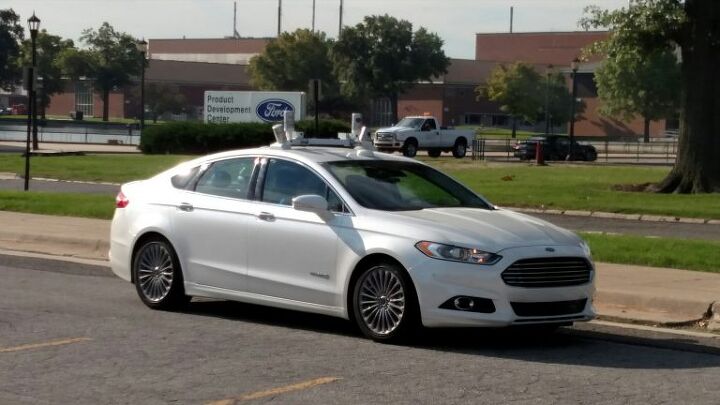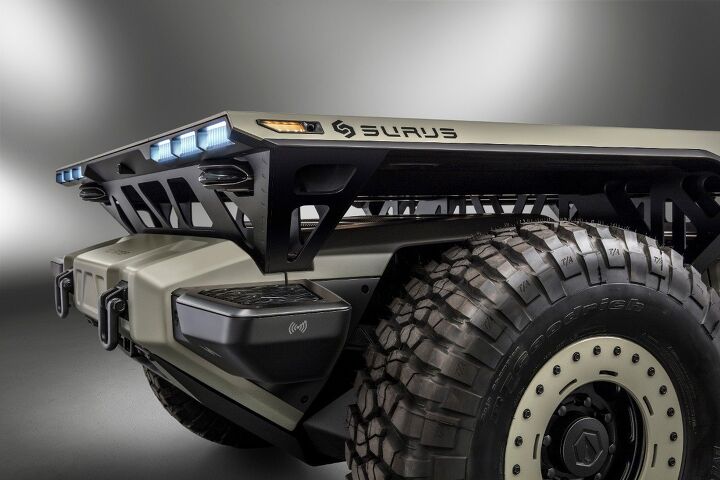#AutonomousVehicles
For All Its Talk of Mobility, Ford Says It's Fine With FCA and GM Leading the Robocar Pack
If recent statements from Ford Motor Company were any indication, you’d think we were living in some futuristic society where our grandparents drove Nucleons and the need for a personal vehicle was almost nil. Yes, too much “mobility” talk gets under the skin.
That said, it’s Ford’s domestic rivals who are actually building and fielding production vehicles that drive themselves — and setting up businesses and partnerships that could make the automakers a bundle on the side. By next year, both General Motors and Fiat Chrysler could have self-driving vehicles roaming America, earning their companies money.
Be our guest, Ford claims. There’s bigger things to worry about.
Musk Is Right About the Media, Rocket-powered Roadsters and Tesla Version 9 Edition
Tesla Motors CEO Elon Musk is correct in asserting just how poorly the media covers his company. We know that because, after he tweeted that Version 9 of the company’s software would allow the firm to begin enabling “fully self-driving features,” numerous outlets started claiming complete driving autonomy was just around the corner. We hate to be the bearer of bad news, but that isn’t what’s happening.
To be fair, much of the confusion came via headlines suggesting Musk had explicitly promised a fully self-driving vehicle. While that’s not even close to what he did, we understand that it’s a heading too tempting for many to refuse. We’re betting Elon grasps this concept as well, which is why he chose his wording so carefully. Frankly, the CEO probably comprehends the media far better than the media understands his company, and he regularly uses this to his advantage.
While several outlets clarified that Tesla was actually implementing a software update (with unclear ramifications in the body of their text), plenty glossed over that aspect of the story. Instead, they decided to tack on Musk’s earlier promise that the Tesla Roadster would be offered with a SpaceX package — 10 small rocket thrusters to improve the vehicle’s dynamics.
Super Cruise Coming to Rest of Cadillac in 2020, Conspiracy Theories Coming by 2023
General Motors intends to start offering its hands-free driving system, Super Cruise, across the entire Cadillac lineup by 2020. The technology, already available on the CT6, allows motorists to take a semi-passive role on the highway. Once GM’s luxury brand is sorted, the system will become available on other makes.
If you like the idea of a car that can take you out of the commute a bit and don’t mind the idea of a small camera permanently pointed directly at your face, then this is probably very exciting news.
While Super Cruise is frequently compared to Tesla’s Autopilot, the two operate differently. General Motors’ system does indeed allow for a similar hands-free experience, but the onboard camera tracks the driver’s eyes to ensure they remain relatively attentive to the road ahead. Meanwhile, Autopilot allows drivers to ignore almost everything so long as they’re willing to regain control of the vehicle when asked. The difference between the two is that the onus of safety remains slightly more with the driver with Super Cruise.
Japan's SoftBank Dumps Cash Into America's Autonomous Vehicles, Sets GM Deadline for 2019
Several months after procuring a large ownership stake in Uber, SoftBank has placed $2.5 billion into General Motors’ self-driving program. The automaker intends to begin deploying autonomous vehicles next year and CEO Mary Barra says her company will invest $1.1 billion of its own funds into the effort to ensure the timeline is adhered to.
Thanks to the hefty investment from SoftBank’s Vision Fund, the Japanese holding company now owns roughly 20 percent of General Motors’ tech subsidiary, known as Cruise Automation. While tech firms and automakers have been driving hard to surpass each other in terms of autonomous development for years, GM currently appears to have the most riding on the hardware.
'They Will Grow Older': Jaguar's Product Boss Is Damn Sure Millennials Will Eventually Choose Self-Indulgence
Teen car culture is dying a swift death, The Atlantic claims, but Jaguar Land Rover’s head of product strategy feels the youngsters of today will eventually outgrow their desire for hassle-free autonomous commute pods.
As a great Jaguar print ad in the 1990s once stated, “Live Vicariously Through Yourself.”
In Hanno Kirner’s mind, this mantra will guide more than a few Millennials to take over the driving duties and indulge their innermost desires. It had better.
NTSB Releases Preliminary Report on Fatal Uber Crash; Vehicle 'Saw' Victim 6 Seconds Before Impact
The Volvo XC90 that hit Elaine Herzberg on a darkened Tempe, Arizona street was travelling 43 mph at the time of impact. Guided by a combination of cameras, radar sensors, and lidar designed to cut through the gloom, the two-ton SUV “saw” the victim 6 seconds before impact, according to a preliminary report released by the National Transportation Safety Board.
The Volvo, operated by Uber Technologies, applied the brakes 1.3 seconds after impact. However, it wasn’t autonomous software that ended up sending pressure the front and rear pistons. A human did that.
Uber Pulls the Plug on Autonomous Vehicle Testing in Arizona
The area around Phoenix, Arizona can say goodbye to the fleet of self-driving Volvo SUVs operated by Uber Technologies. The ride-sharing company, which suspended all on-road autonomous vehicle testing after a fatal pedestrian collision in March, has announced it’s shutting down its operations in that state.
Up to 300 employees stand to lose their jobs.
While the departure hints at a newfound culture of caution and discipline at Uber, it isn’t terminating its self-driving program altogether, nor will its conventional services leave Arizona. The company’s self-driving vehicles could be on the road again this summer.
Camera-guided Ford Fusion Sails Through Red Light; Supplier Blames … Other Cameras
Mobileye, the Israeli company that supplies camera-based driver assist technology to a host of automakers, just received a black eye.
While one of its Ford Fusion Hybrid testbeds cruised through the streets of Jerusalem to show off its autonomous driving abilities, the sedan, equipped with 12 cameras (three of them forward facing), four advanced EyeQ4 chips, and a television audience, drove merrily through a red light.
It’s technically not the car’s fault, Mobileye said. It’s the TV crew’s.
In Wake of Crashes, Public Confidence in Self-driving Cars Pulls a U-Turn
Following a Wild West-like expansion in autonomous vehicle testing, coupled with years of rosy predictions from automakers and Silicon Valley types, the public seemed ready to embrace self-driving cars with open arms.
Opinion polls showed significant distrust in the technology, but least among young adults, the idea of self-driving cars remained a popular one. That’s changed, apparently.
General Motors Files Patent Application for 'Transforming' Cars
General Motors has filed one of the strangest patent requests we’ve ever seen, one that gives vehicles the ability to change their shape. Up until now, a GM-branded transformer was something that only existed in the movies. But it would seem the automaker hopes to develop a real-world example someday.
While the concept and patent drawings mirror an idea I developed as a six-year old with a box of crayons, it does have some practical applications. GM has made it clear it sees a future rife with autonomous vehicles and ride-sharing. However, operating a theoretical fleet of self-driving vehicles comes with numerous hurdles. One of the biggest is finding a place to store them.
Having computer-controlled cars mill about endlessly is inefficient, but so is storing them in a central hub. Ideally, you would locate them in small clusters near the area they’re meant to serve. That’s easier said than done in urban environments. But if a car could somehow collapse itself to half its normal size, new parking opportunities suddenly become available.
Report: Self-driving Uber Vehicle Involved in Fatal Collision Saw, Ignored Pedestrian
The fatal collision between an autonomous Volvo XC90 operated by Uber Technologies and 49-year-old Elaine Herzberg in March could have been prevented, had the vehicle’s software not dismissed what its sensors saw.
That’s what two sources briefed on the issue told The Information, but Uber isn’t divulging what led to the Tempe, Arizona collision. What it will admit to, however, is the hiring of a former National Transportation Safety Board chair to examine the safety of its self-driving vehicle program.
Thwarted on the On-ramp: Waymo Driverless Car Doesn't Feel the Urge to Merge
Tempe, Arizona, that sunny hotbed of autonomous vehicle testing, made headlines earlier this year after a driverless Volvo XC90 operated by Uber Technologies struck and killed a woman crossing a darkened street. The “driverless” vehicle, which had a (distracted) Uber employee behind the wheel, apparently didn’t see the victim. Uber suspended testing after the incident.
Now, Tempe’s making headlines again. A Waymo-operated Chrysler Pacifica found itself the victim of a collision on Friday afternoon, but it’s the behaviour of another Waymo minivan — caught on video by another motorist — that’s generating the most interest today.
Pentagon Joins Tech Startups in Race for Autonomous Vehicles
It’s been a rough road for autonomous vehicles. Despite development progressing significantly over the last decade, tech companies and automakers have been confronted with a myriad of issues. There have been intellectual property lawsuits, public safety concerns, and a recent backlash from government officials who are starting to wonder if the entire concept has been oversold.
However, the government still wants self-driving cars, especially the Pentagon. The Defense Advanced Research Projects Agency (DARPA) has been researching autonomous cars since the technology was in its infancy and, with so many firms trying to bring the technology to market, the military sees no reason it shouldn’t be the first.
It’s not like it doesn’t have the money.
Are Government Officials Souring On Automotive Autonomy?
Thanks to the incredibly lax and voluntary guidelines outlined by the National Highway Traffic Safety Administration, automakers have had free rein to develop and test autonomous technology as they see fit. Meanwhile, the majority of states have seemed eager to welcome companies to their neck of the woods with a minimum of hassle. But things are beginning to change after a handful of high-profile accidents are forcing public officials to question whether the current approach to self-driving cars is the correct one.
The House of Representatives has already passed the SELF DRIVE Act. But it’s bipartisan companion piece, the AV START Act, has been hung up in the Senate for months now. The intent of the legislation is to remove potential barriers for autonomous development and fast track the implementation of self-driving technology. But a handful of legislators and consumer advocacy groups have claimed AV START doesn’t place a strong enough emphasis on safety and cyber security. Interesting, considering SELF DRIVE appeared to be less hard on manufacturers and passed with overwhelming support.
Of course, it also passed before the one-two punch of vehicular fatalities in California and Arizona from earlier this year. Now some policymakers are admitting they probably don’t understand the technology as they should and are becoming dubious that automakers can deliver on the multitude of promises being made. But the fact remains that some manner of legal framework needs to be established for autonomous vehicles, because it’s currently a bit of a confused free-for-all.
Toyota Confirms 'Talking' Cars for 2021
Toyota wants to be a leader in the connected vehicle field and is encouraging all automakers to utilize dedicated short-range communications (DSRC) on all of vehicles sold in the United States — especially after it has already decided to do so with its own fleet. The brand has said it will be building talking cars by 2021. But they won’t talk in the same sense as a 1987 Chrysler New Yorker constantly reminding you that the door is ajar in a Speak & Spell voice, nor will they communicate with you like modern-day vehicles equipped with Amazon’s spyware intelligent personal-assistant service.
Instead, they’ll be talking to each other via a dedicated channel for vehicle-to-vehicle (V2V) communications. Toyota and Lexus intend to start equipping models with the technology in 2020, hoping to have it on most models by the following year. But it wasn’t the first to pitch the idea. The Federal Communications Commission allocated specific bandwidths for car chatter in 2017 and Cadillac has been talking about V2V for years.






























Recent Comments